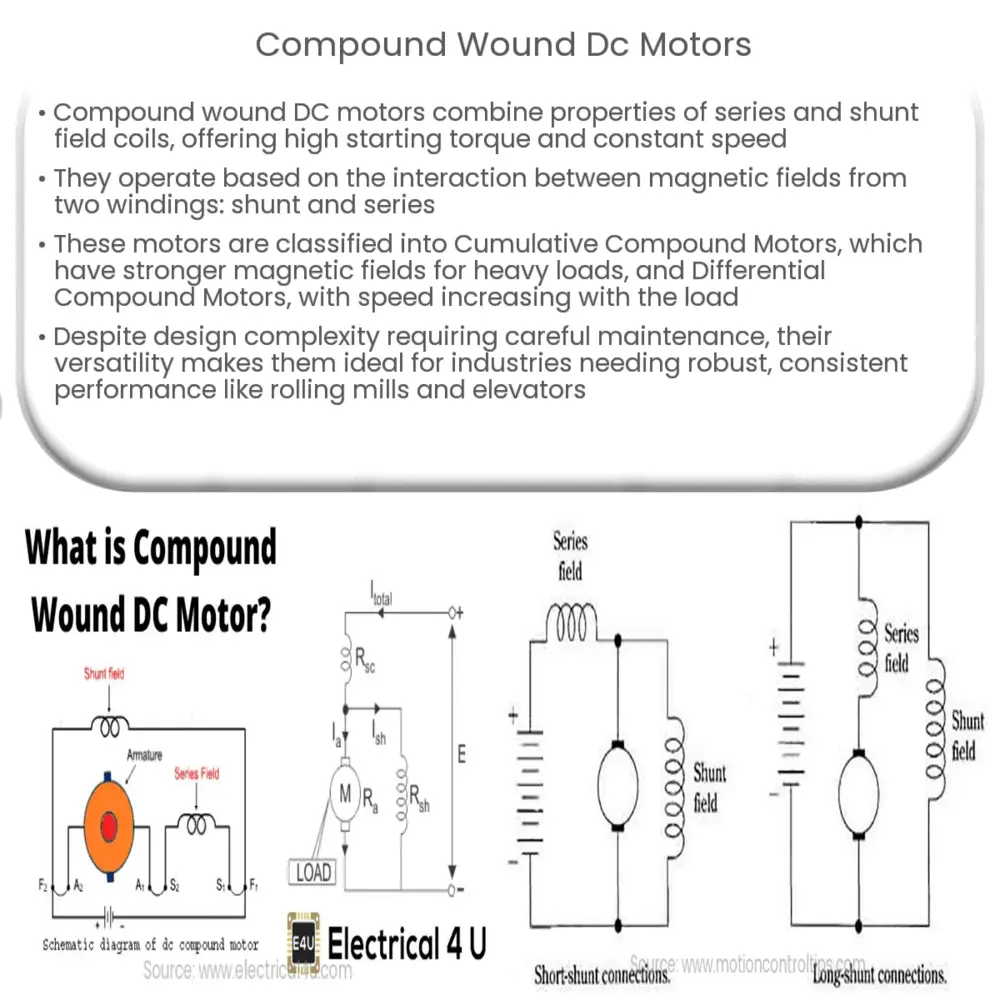Explore the principles, types, characteristics, pros & cons, and applications of compound wound DC motors in this comprehensive guide.

Introduction to Compound Wound DC Motors
A compound wound DC motor, also known as a DC compound motor, is a type of electric motor characterized by a mix of both series and shunt field coils, granting it properties from both these types of DC motors. This combination allows the compound wound DC motor to offer unique advantages in applications where both high starting torque and constant speed are required.
Principle of Operation
The principle of operation of a compound wound DC motor is based on the interaction between magnetic fields. The motor consists of two windings: the shunt winding (parallel to the armature) and the series winding (connected in series with the armature). The combined effect of these windings, which results in an improved torque-speed characteristic, makes this motor a versatile tool in many industries.
Types of Compound Wound DC Motors
- Cumulative Compound Motor: The magnetic fields of the series and shunt windings in a cumulative compound motor add together, resulting in a stronger overall magnetic field. This provides an increase in torque, making it suitable for heavy load applications.
- Differential Compound Motor: In differential compound motors, the magnetic fields of the series and shunt windings oppose each other. The speed of this type of motor increases with the load, making it less common in practical applications.
Characteristics of Compound Wound DC Motors
Compound wound DC motors exhibit a combination of the characteristics of both series and shunt DC motors. They provide high starting torque due to the series field, and nearly constant speed with varying load due to the shunt field. With the potential to offer both high starting torque and good speed regulation, compound wound DC motors are widely used in industry.
Advantages and Disadvantages of Compound Wound DC Motors
Like any machine, compound wound DC motors have their advantages and drawbacks. Their primary advantage lies in their flexibility and versatility, with high starting torque and good speed regulation. However, the complexity of their design, particularly the need for both series and shunt windings, can be a disadvantage in terms of maintenance and operational complexity.
Applications of Compound Wound DC Motors
Due to their unique characteristics, compound wound DC motors are used in a variety of applications. Their high starting torque and stable operating speed make them ideal for applications that require a robust and consistent performance.
- Rolling Mills: These motors are well-suited for heavy machinery applications like rolling mills, where a strong initial push is required.
- Elevators: The high starting torque and nearly constant speed make compound wound motors ideal for elevators and hoists.
- Presses and Lathes: These motors are commonly used in mechanical industries that use presses and lathes, where constant speed is crucial despite varying load conditions.
- Electric Trains and Cranes: The strength and reliability of compound wound DC motors make them a popular choice in transportation and heavy lifting equipment such as electric trains and cranes.
Maintenance and Precautions
Given their design complexity, compound wound DC motors require careful maintenance. It is important to ensure that both the series and shunt windings are functioning properly. The commutator and brushes should also be checked and replaced regularly to prevent damage and ensure long-term motor performance. In terms of safety, precautions should be taken to avoid any potential risks associated with high voltage and current, especially during maintenance procedures.
Conclusion
Compound wound DC motors, with their unique combination of series and shunt field coils, provide a versatile solution to many industrial applications. Offering high starting torque and nearly constant speed, they are particularly suitable for heavy machinery applications, elevators, and variable load conditions. Despite their complexity and the need for meticulous maintenance, the advantages they offer often outweigh their drawbacks. As technology advances, we can expect further enhancements in the design and functionality of these motors, opening new possibilities for their application in various sectors.

